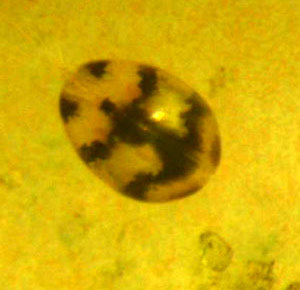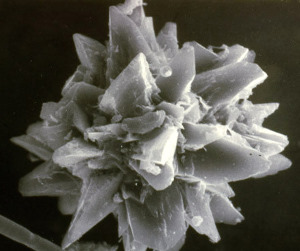Diatoms are single-celled algae that thrive and multiply in ponds and streams during favorable conditions known as blooms. When these tiny organisms die, their cellular contents are often preserved in silica. Because different taxa have varying tolerances for extremes of temperature, salinity, water depth, water clarity, and nutrient concentrations, diatoms are particularly useful in reconstructing aquatic paleoenvironments.
Ostracods are microscopic crustaceans (known popularly as "seed shrimp") characterized by a hinged bivalve shell made of calcite. Ostracods range in size from 0.5 to 2 mm. They are diverse and abundant in both freshwater and marine environments. Two of the common ostracods in marshes are Cypridopsis vidua and Cypridopsis okeechobei.
Phytoliths are tiny microscopic silica particles (plant stones) that develop within the cells of most plants. Dissolved silica is transported into growing plants through water and then deposited along cell walls as silica particles. Different kinds of plants and different parts of a plant develop phytoliths of distinctive shapes. After the plants die, the silica bodies become part of the mineral component of soils left in the ground. For the Landis project, phytolith studies are important in reconstructing an approximate profile of grassland flora in this Plains setting and tracking possible changes through time. In grasses, phytoliths exhibit diversity and are distinct for grass species. The presence of certain phytoliths (e.g., panicoid, festucoid, and chloridoid) in the paleoenvironmental record provides a record of general vegetative conditions, such as forested versus open grassland prairie, and the type of grasslands.
Pollen grains and spores are the fine powdery material produced on the stamens and anthers of seed plants. The grains are minute in size, each ranging from 15 to 100 microns. To understand the scale, consider that the head of a pin is about 2 mm (2000 microns) in diameter. Just a pinch of pollen powder contains thousands of grains. Because each pollen type has a unique set of attributes (size, shape, and characteristics of the outer wall), analysts can usually identify the species or plant family from which it originated. Pollen collected from an archeological site can provide insights into what the overall environment was like at the time the site was occupied and how area vegetation changed through time.
Stable Carbon and Nitrogen Isotopes A stable isotope is an isotope not subjected to radioactive decay, such as carbon (C13), oxygen O18, or nitrogen (N15) isotopes. (These contrast with radioactive isotopes such as carbon-14 that decay over time.) During the Landis project, analyses were performed on bison bones and soil samples collected from dated contexts. Analyses of materials such as these can provide indications of what types of grasses (C3, cool season, or C4, warm season) were present at different time periods. In the case of bison, the values measured in the bone directly reflect the animals grazing/consumption patterns.
Stable isotope values were also measured on ostracods (specifically, Cypridipsis). Fifty-two valves were used as samples.
|

Ostracod (Cypridopsis vidua). This tiny shrimp-like creature is common in marshlands. Image courtesy of Wikipedia.  |

Phytolith, or plant microfossil, as viewed through a scanning electron microscope (SEM), showing the distinctive three-dimensional structure identifying it as prickly pear (Opuntia). The image shown is from Hinds Cave in the Lower Pecos area. The predominant, and most useful, phytoliths from the Landis project area were from grasses. These provided insights into grass communities not reflected in the pollen samples. Image courtesy Texas A&M University Anthropology Archives.  |

Stable carbon isotope analyses on bison bone provide indications of whether the animals consumed cool or dry grasses.  |
|